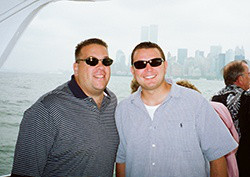 Today we’re sharing insight from Gibson guest bloggers Andrew Graman, Senior Client Manager and Andrew Schroeder, Assistant Controller. We hope you enjoy their wisdom and perspective!
Today we’re sharing insight from Gibson guest bloggers Andrew Graman, Senior Client Manager and Andrew Schroeder, Assistant Controller. We hope you enjoy their wisdom and perspective!
Schroeder and Graman. Graman and Schroeder. But you can call us Andrew.
Although we have only been colleagues at Gibson since August 31, 2015, we have known each other for quite a while: August 20, 2009, to be exact. As residents of Burford Hall at Indiana State University, we immediately became known as “The Andrews” by the rest of the floor and many of our mutual friends, and still are to this day.
In the process of becoming great friends, we slowly figured out that although we both had similar goals, how we pursued accomplishing those goals was quite different. It extended past the classroom into most aspects of our daily lives. For example, in a game of pickup basketball, you could count on one of us finding a way to get open for the next three-point shot, while the other would be out-hustling you to the loose ball or volunteering to play lock-down defense on the other team’s best player. We’ll let you guess who was who.
But why let two millennials talk about a pickup game of basketball in college in a blog typically dedicated to leadership development, life lessons, and career advice from experts in numerous fields? Because it’s what guys do, right? Talk sports?
That; and it has everything to do with how we have developed as leaders for as far back as we can remember.
Leadership development is an ongoing journey, one that arguably may never truly have a destination since there is always some way to improve. In today’s world, you can find many different approaches on “best practices” for leadership through books, videos, podcasts, you name it. We almost become numb, as information overload makes it tough to filter at times to see who has the secret recipe for leadership success. But as we sat down and discussed our leadership journey thus far, we agreed there are two main concepts that summarize our leadership journey.
The first is internal personal professional development. The best leaders are not born fully formed, well rounded, and perfect. Leaders have to understand themselves, their tendencies, and their natural skills. Once the strengths and weaknesses are realized, one must capitalize on the strengths and be cognizant of further opportunities to develop in weaker areas. It’s realizing you aren’t the fastest or the strongest, but practicing a jump shot in the backyard until you can do it in your sleep. Knowing what you bring to the table is key, as understanding those around you is nearly impossible without understanding yourself.
The second type of leadership development is more external, centered on the concept of “team” and creating an environment for success. Once a leader understands himself or herself, he or she can then effectively develop the skills to help others. Team success becomes the main target, and personal growth hinges on how you interact with those around you. Being the a lone wolf only goes so far in today’s business environment, and the ability to work in teams is crucial to long-term success. It’s why some of the best players have the discipline to become the best shooter on the floor, but take the time studying the playbook and each person’s role on the team before taking the floor each night.
Luckily, we’ve had a couple formal opportunities to develop each of those levels of leadership. The first being the Networks Professional Development Program at Indiana State University, with the more recent involving the Gibson Leadership Academy.
January marked the beginning of the Gibson Leadership Academy, a nine month in-house leadership program involving 12 individuals from all departments and locations within Gibson. The program started with a DiSC assessment to learn about our natural tendencies, see our diversity, and understand the differences we have within the group. Using the information gathered from the DiSC assessment, we each went through monthly individual coaching sessions to help capitalize on strengths, set short and long term leadership goals, and understand one’s own self more fully. Not only was it informative from a personal perspective, but also important to build the kind of empathy needed to understand others’ actions.
Once we better understood ourselves and the make-up of the team, we moved to an external approach, where we focused on how we come across to others. Each of the monthly Gibson Leadership Academy group meetings somehow hinged on how our personality types affect anything from conflict management to a simple “How was your weekend?” in the hallway. We all have unique make-ups that allow us to be suited for different teams, tasks, and projects here at Gibson, and capitalizing on those strengths is how we can move forward even faster as a company.
Now, when we walk around the office and communicate with our colleagues, we can more tactfully approach the individual based upon his or her preferred style. Understanding how others operate internally and empathizing with them helps bridge the gap between what may once have been a tumultuous relationship. Jumping back to the pickup game at “The Rec” in college, it’s the reason that although we both had the same goal of winning the game, we approached it in completely different ways. One of us was operating in the most efficient way we knew how to win, while the other was simply pushing as hard as possible to get the victory, no matter how much effort it took.
What’s The Risk?
Simply: ignorance. If we don’t take the time to learn about ourselves and those around us, how will be ever understand how to work together to accomplish the tasks at hand? We are all unique individuals, each operating in our own way, and that’s what makes teams so great. It is the mixture of ideas, approaches, and personalities that go further than one person can alone. It doesn’t take rocket science or a specific test to understand how your colleagues operate, rather simply taking the time to observe how they do business and allowing them to perform in an optimal environment.
In a hyper-competitive marketplace for talent, if you don’t take the time to develop your leaders, someone else will.
This content was written and shared by guest bloggers Andrew Graman and Andrew Schroeder.
 Andrew Graman is a Senior Client Manager in the Employee Benefits Practice. He works directly with clients and oversees team members to support all client needs, including renewal, marketing, ongoing service, enrollments, compliance, data management, and employee meetings.
Andrew Graman is a Senior Client Manager in the Employee Benefits Practice. He works directly with clients and oversees team members to support all client needs, including renewal, marketing, ongoing service, enrollments, compliance, data management, and employee meetings.
Connect with Andrew on Twitter and LinkedIn.
 Andrew Schroeder is an Assistant Controller at Gibson. He is responsible for providing financial reporting, modeling, and analytics of data and trends. Additionally, Andrew assists the CFO with strategic initiatives.
Andrew Schroeder is an Assistant Controller at Gibson. He is responsible for providing financial reporting, modeling, and analytics of data and trends. Additionally, Andrew assists the CFO with strategic initiatives.
Connect with Andrew on Twitter and LinkedIn.



